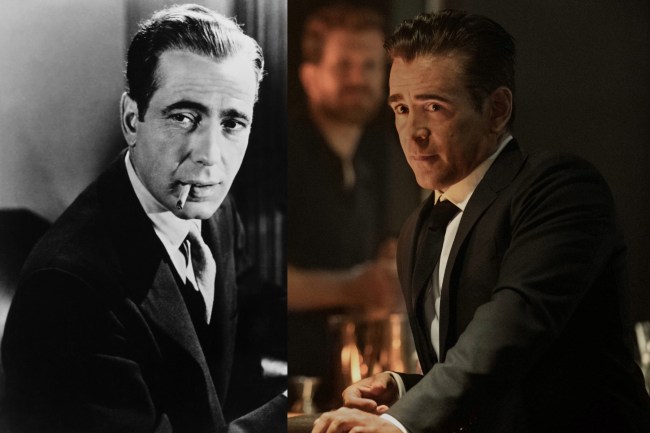One of the most distinct characteristics of the new Apple TV+ series “Sugar” is the way it cuts scenes from classic Hollywood films into its present day story of detective John Sugar (Colin Farrell). While the technique is novel, if not experimental, the connections being made are clear: Sugar is a cinephile obsessed with old Hollywood movies, while creator Mark Protosevich’s neo-noir series is steeped in the tropes of these 1940s and 50s black and white films. (Episode 1 features “Kiss Me Deadly” and “The Big Heat” being intercut.)
The connections are so strong, and the intercutting works so well, the real surprise is that cinephile Protosevich didn’t script them.
“It was all done after the fact, so I had no idea until I saw it how many [and] which clips [they used],” Farrell told IndieWire, adding he was pleasantly surprised to see himself juxtaposed with some of his all-time favorite films, like “Sunset Boulevard” and the “The Maltese Falcon.” “It’s a really fun alignment for me, as a lover of film and a lover of this story.”
The irony being the intercutting was the brainchild of two Brazilian filmmakers, director Fernando Meirelles and his long-time editor Fernando Stutz, who were not well-versed in the film noirs the showrunner was drawing upon.
“The first thing Mark did was give me 15 films to watch, to start our conversation,” said Meirelles who admitted to the showrunner in their first meeting he wasn’t well versed in film noir. “I watched [them] nonstop, and I loved it. One of the things that I loved about the scripts, after watching the films, is I recognized a lot of lines from different films, or a specific situations from a film, that were in the script.”
Stutz also binged Protosevich’s 15-film homework assignment, and then went further watching even more, as he marinated in the world of noir as footage from the shoot started to flow into his editing room.
“And then from there, while cutting, sometimes it pops into your head, ‘Oh, okay, Sugar is discovering something here, I remember Peter Lorre doing [that],” said Stutz, making reference to the great 1940s Hollywood character actor who will make an appearance in a later episode of “Sugar.”
“I’m always thankful for [Meirelles] because he encourages me to experiment, he’s not afraid, so I just started to combine the two,” said Stutz, who is a student of experimental film. “The uniqueness of what we do and the medium we work at is the clash of images. I’m very interested in bringing these different sources together, and to see what effect it causes.”
The editor’s earliest experiments instantly registered with Meirelles, who encouraged Stutz to do more. It’s normal for the two collaborators to talk throughout production, and their conversations increasingly started to focus on connections between what the directors was shooting and the movies they’d watched. For Meirelles, making the visual connections “Sugar” and its influences fit his understanding of the character, which is why the intercutting works so well.
“Listening to Sugar’s backstory, as Mark told it to me, he was like an anthropologist, [except] Sugar would watch a lot of films to understand [people],” said Meirelles. “So every time he’s in action, the specific actions reminds him of something that he watched. The black and white inserts are what is in his mind.”
Licensing old movies is not cheap, in addition there were estates of some former stars who denied usage of their image. Meirelles and Stutz estimated between 30 to 40 percent of the old movies they initially used had to be replaced. To save money, Stutz would replace some of the classic movie footage with older stock footage, especially for driving shots, and traveling through Los Angeles. Despite being disappointed that he had abandon some of his work, he was surprised by how easy it was to find alternatives.
“It’s funny because there are there are so many similarities that we are not aware of,” said Stutz. “‘Sugar’ is a self-reflexive project, and a very good excuse to think about filmmaking and film tropes. That’s what is part of the beauty for me, you notice how film language evolves, and in a way it doesn’t evolve.”







